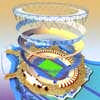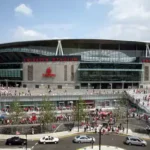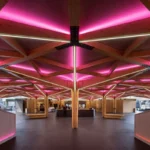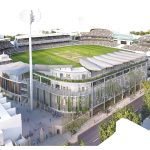London Olympics Stadium Building, West Hamm Football Ground News, Construction Start, Image
London Olympic Stadium Building
2012 Architecture: New West Ham Football Ground, England, UK
12 Feb 2011
London Olympic Stadium Legacy – West Ham Win
London Olympic Stadium Legacy News
West Ham were voted as preferred bidders for the Olympic Stadium. West Ham’s successful bid includes the retention of the athletics track. The rival failed bid from Tottenham Hotspur involved removing the track.
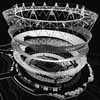
Olympic building image © Populous
Spurs’ plan to build a football-only stadium on the site of the main venue for the 2012 Olympics in east London had caused controversy as an athletics legacy was part of the capital’s successful bid to host the 2012 Olympic Games.
Olympic Park Legacy Company (OPLC) executives unanimously chose the West Ham bid today as it was judged to provide the best legacy. The OPLC board’s decision still needs to be ratified by London Mayor Boris Johnson and two government departments but is very unlikely to be overruled. Retention of the running track at the stadium needs to be legally binding.
Focusing on the architecture in summary we have the Olmypic Stadium retained – being used for football and athletics – and Tottenham Hotspur can now proceed with their £400m stadium on the site of their current home at White Hart Lane. e-architect previously showed the design by KSS for this:
Tottenham Hotspur Football Club Stadium Proposal
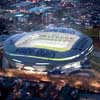
image courtesy of KSS
Tottenham Football Club Stadium
24 Jan 2011
London Olympic Stadium Legacy – West Ham or Spurs?
We are not prepared to ‘trash our international reputation’
Lord Coe slams Tottenham’s Olympic Stadium Plans
West Ham chief Karren Brady also continues to attack Spurs’ bid
Chairman of the 2012 London Olympics Lord Coe has slammed Tottenham’s plans to occupy the Olympic Stadium in east London following the Games.
Spurs are currently battling West Ham for the right to take control of the stadium and if successful, plan to knock the stadium down and replace it with one that they say is more suitable for hosting football. They do, however, state that they would redevelop the current athletics facilities at Crystal Palace, south London.
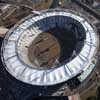
London Olympic Stadium photo from Olympic Delivery Authority
However, Lord Coe, who led the bid in 2005, isn’t convinced and claims that the London Olympic Stadium plans by Spurs would undermine the Games’ legacy.
“It’s really serious we deliver on what we said we were going to deliver, unless we are prepared to trash our international reputation. If we don’t, it would be difficult to be taken seriously in the corridors of world sport.
“I remember delivering a vision about a generation of young people being inspired to take up Olympic sports. I’m prepared to revisit my words that day but I genuinely don’t recall a whole heap about bulldozing down a publicly-funded facility, replacing it with a Premiership football club and inspiring a generation of Tottenham Hotspur Football Club season-ticket holders.
“I find it inconceivable grandparents will take children back to a Premiership football ground and say somewhere among this lies dormant the memories of Jessica Ennis or Usain Bolt reaching the heights of sport. It just does not smell right.”


London Olympic Stadium pictures from Olympic Delivery Authority
Meanwhile, West Ham Football Club vice-chairman Karren Brady has also furthered the debate, questioning Tottenham Hotspur Football Club manager Harry Redknapp’s impassioned call for plans by Spurs to go ahead.
She said: “Harry has got his own agenda, no doubt given to him by his board to deliver. When he was asked before for his view of Tottenham moving to the Olympic Stadium, he said, ‘That’s West Ham territory, isn’t it?’ It’s amazing what pressure can be put on you to change your opinion.
“Harry seems to have been briefed that we are simply moving our goalposts there. That is not true. This is being built by Westfield, an outstanding company, and one of the ideas is to move seats closer behind the goal. I’d be a lot more worried about Spurs filling their stadium because of all the demonstrations I have seen from the Tottenham Hotspur supporters who are against moving. “But this is much bigger than Harry’s point of view. He is bordering on hysteria.”
Decision was to be made on Friday 28 Jan but the ODPLC deferred the decision – e-architect will report the decision here
23 Jan 2011
Lord Coe supports West Ham United’s Olympic Stadium plans
London 2012 chairman Lord Coe has backed West Ham United’s plans to move from Upton Park into the Olympic Stadium in Stratford after next year’s Games.
The chairman believes that there is a “moral obligation” to preserve the stadium as a multi-sports facility, which puts a further question-mark over the board’s January 28 deadline decision – reportedly favouring Tottenham Hotspur’s rival plans.
Spurs plan to demolish the Olympic Stadium and build a completely new one dedicated to football, scrapping the athletics track. They feel such a track is inappropriate for a football-only venue as it separates the fans from the action, detracting seriously from the atmosphere and enjoyment of the matchday experience.
Lord Coe, however, thinks there are important issues at stake. “It’s serious we deliver what we said we were going to unless we’re prepared to trash our reputation,” he said, according to The BBC.
“It’d be very difficult for us to be taken seriously in the corridors of world sport and arguably beyond [if we reneged on our promise when bidding to host the Games].”
West Ham’s bid has been backed by the council, as they plan to move two miles from their current Boleyn Ground at Upton Park and redevelop the Olympic Stadium to incorporate both football and multi-sports.
Tottenham would move five miles from their home at White Hart Lane, but plan to remove the 400-metre track and build a football-only stadium, pledging to invest money into redeveloping the current home of British Athletics at Crystal Palace and turn it into a world championship-standard venue.
Tottenham’s chairman Daniel Levy announced his plans and vision on BBC Radio Five Live, but Lord Coe’s position is that he led the 2012 Olympic bid by promoting athletics, not football.
“I remember delivering a vision about a generation of young people being inspired to take up Olympic sports, I remember talking about young people in a poor community in East London fashioning their future through sport,” he said.
“I’m prepared to revisit my words but I don’t recall a whole heap about bulldozing down a publicly-funded community facility, replacing it with a football club and inspiring a generation of Tottenham season ticket holders, however many there may be on a waiting list.”
21 Jan 2011
Pele backs Tottenham’s bid for Olympic Stadium: I don’t understand why you would want to play with a track around the pitch
Brazilian legend Pele has weight into the debate over the future of the London Olympic Stadium by saying Tottenham should be the team allowed to move in after 2012.
Spurs want to remove the running track from the ground to create more of an atmosphere and Pele has shown his support through a letter.
“I understand they are based on creating a dedicated football stadium and providing an athletics legacy at the original home of athletics, as I remember it, Crystal Palace,” he said.
“That would be a great stadium. I really don’t understand wanting to play with a track around the pitch. The players won’t like it and it probably won’t last.
“As a player I need to feel the passion and the intensity of the fans. The best stadiums connect the fans to the pitch and if you lose that you lose something that really matters and eventually you lose the fans.
“The Olympics is special too and it would be good to see a decision taken which means that we see excitement and great sport experiences follow it too.”
18 May 2010
Olympic Park Aerial Images
The Olympic Delivery Authority (ODA) has today released new aerial images of construction progress on the Olympic Park showing the ‘big build’ firmly on track as the project continues in its busiest year to date.
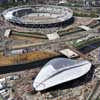

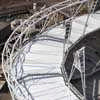
London Olympic Stadium pictures from Olympic Delivery Authority
The new aerial images, taken this month, show the construction progress on the ‘Big Five’ venues (Olympic Stadium, Aquatics Centre, Village, Velodrome and IBC/MPC) as well as further progress on the new infrastructure and landscaping works across the Olympic Park that will help create the UK’s largest urban park for over a century. The new images follow the latest figures released by the ODA last week which show there are nearly 10,000 people currently working on the Olympic Park and Olympic Village.
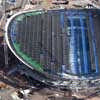
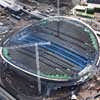
London Olympic Stadium pictures from Olympic Delivery Authority
Also included in the new images is the first glimpse of a new bridge constructed in Stratford that will create improved links for local people when it is opened in the summer and which has paved the way for transport improvements at Stratford Regional Station that will benefit local people before, during and long-after the Games.
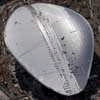
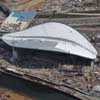
London Olympic Stadium pictures from Olympic Delivery Authority
The latest Olympic Park aerial shots show:
– The Olympic Stadium at its full height with all 14 lighting towers now in place and work well underway on covering the cable-net roof
– The wave-shaped Aquatic Centre steel roof structure in place with roof covering work well underway. The concrete dive pool and two 50m competition and training pools have also been completed and tested
– The distinct double-curved roof of the Velodrome lifted into place and work on the roof covering well underway
Olympic Park Aerial Images from ODA 180510
26 Aug 2008
Olympic Stadium begins to rise out of the ground
Progress on the 2012 Olympic Park became clearly visible this week as new images reveal the columns of the Olympic Stadium emerging from the ground.
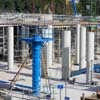

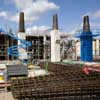
London Olympic Stadium pictures from Olympic Delivery Authority
Over 100 columns, each 5 meters tall, have already been constructed and act as the support for the podium of the Stadium’s west and south stands. This also forms the lower ground floor of the West Stand which houses the athletes’ changing rooms, a 60metre long call track and other back of house facilities such as doping control and treatment rooms.
The work to create the foundations for the Olympic Stadium is also nearing completion with over 3500 of the 4,000 permanent piles already installed.
ODA Chairman John Armitt said: “As the eyes of the world turn from Beijing to London, they will see that real progress is being made to create the new venues and infrastructure for the 2012 Games.
“As these new images show, the Olympic Stadium is already beginning to rise out of the ground and over the coming months, we will begin to see the size and scale of this flagship venue. There is still a long way to go and we are not complacent about the challenges ahead, but we have made a strong start out of the blocks.”
In May this year, construction started on the Stadium site three months earlier than originally planned and was witnessed by Prime Minister Gordon Brown. Eight tower cranes, each between 48 and 60 meters high, have also now all been erected in the Stadium ‘bowl’ for the concrete work and steel and roof erection.
The work is also now underway on the abutments that support the first of the five pedestrian footbridges over waterways that surround the Stadium site. During the Games the bridge will be one of the main connections for spectators to and from the Stadium to the east of the Olympic Park.
A pre-cast concrete batching plant has been set up on the south part of the Olympic Stadium site to cast almost 200 rakers, the concrete structures that will support the seating units for the lower 25,000 permanent seats. The concrete will be supplied from the batching plant on the Olympic Park site which will reduce vehicle movements in the local area.
London Olympic Stadium construction progress images / information from ODA 260808
Previously:
22 May, 2008
Olympic Park construction gets early start
Prime Minister visits Olympic Park as building work gets underway
Construction officially started on the London 2012 Olympic Park today as the Olympic Delivery Authority (ODA) began work on the Olympic Stadium – three months earlier than originally planned.
The work to create the permanent foundations for the Stadium was witnessed by Prime Minister Gordon Brown who had an opportunity to meet workers on site. In the next few years over a thousand workers will help build the venue.
The Stadium will be the centre-piece for the London 2012 Games with over 4bn people across the world watching the Opening and Closing Ceremonies and the track and field events.
Visiting the Olympic Park site, Prime Minister Gordon Brown said:
“The Olympic and Paralympic Games will mark a fantastic celebration in 2012 as Britain hosts the world’s greatest sporting event. The Games offer a unique opportunity to change the lives of young people through sport and the positive effects will be felt long after the Games have finished.
“The early start to building work on the Olympic Park site is good news, taking us another step closer to 2012 and the regeneration of one of the country’s most deprived areas. I have no doubt that the construction of the new permanent venues, infrastructure and transport links within the largest new urban park to be created in Europe for 150 years will be a catalyst for lasting social and economic change in east London.”
Mayor of London Boris Johnson said:
‘Starting the Stadium construction three months ahead of schedule is a tremendous achievement and I congratulate those who have worked tirelessly and professionally to make this happen.
“As I told the International Olympic Committee this week, I am determined to make sure that London does the Games proud, and that the Games leave a lasting legacy which every Londoner can enjoy and be proud of.”
London Olympic Park construction start info from ODA 220508
London 2012 Olympics Athletes’ Stadium Consortium
7 Nov 2007
NEW ERA OF STADIUM DESIGN BEGINS WITH OLYMPIC STADIUM
Innovative design unveiled as ODA plan to start construction on stadium site early
The Olympic Delivery Authority (ODA) today unveiled the design for the Olympic Stadium, the flagship venue for the 2012 Olympic and Paralympic Games. The ODA also plan to start the construction of the venue ahead of schedule.
The unique 80,000 seat stadium will be the centre-piece for the 2012 Games hosting the Opening and Closing Ceremonies and the athletics events, converting down to a 25,000 seat permanent stadium after the Games when it will become a new home for athletics, combined with other sporting, community and educational uses.
An Olympic Stadium with such a large demountable element has never been attempted before and the design represents the start of a new era for Olympic Stadium design – more use of temporary elements combining the high-level performance needed for a major sports event alongside the long-term needs of the community.
The main features of the design are:
– Bowl – a sunken bowl built into the ground for the field of play and lower permanent seating, designed to bring spectators close to the action;
– Seats – 25,000 permanent, 55,000 demountable;
– Roof – a cable supported roof will stretch 28 metres the whole way around the Stadium, providing cover for two thirds of spectators;
– Wrap – a fabric curtain will wrap around the stadium structure, acting as additional protection and shelter for spectators;
– Pods – facilities such as catering and merchandising will be grouped into self-contained ‘pod’ structures, adding to the spectator experience around the access level of the Stadium.
ODA Chairman John Armitt said:
“London’s Olympic Stadium is designed to be different. ‘Team Stadium’ have done a fantastic job against a challenging brief – their innovative, ground-breaking design will ensure that the Olympic Stadium will not only be a fantastic arena for a summer of sport in 2012 but also ensure a sustainable legacy for the community who will live around it.
“The rapid progress we are making in clearing and cleaning the site means that we are now planning to start construction of the stadium on site next year two to three months early.
“This is great news and a tribute to the hard work of all involved. The stadium is also on budget, as announced to the London Assembly last month.
“Together with the opening of St. Pancras yesterday, from where high speed Javelin trains will carry thousands of spectators to the Olympic Park in 2012, the project is very much on track.“
Chair of the London 2012 Organising Committee Seb Coe said:
“We talk a lot about milestones, but few will be more exciting than this, the unveiling of the Olympic Stadium, which will be the centre piece of our Olympic Park. The stadium will stand for everything we talked about in the bid: it will be inspiring, innovative and sustainable – the theatre within which the Olympic Games and Paralympic Games will be played out and leaving behind top class sporting and community facilities after the Games.
“We genuinely believe that this creates a new blueprint for building Olympic stadia – one which integrates Games time requirements with a long-term legacy vision.”
Olympics Minister Tessa Jowell said:
“The designs unveiled today are stunning – a truly imaginative and original concept.
“But this is only part of the story. We will ensure that the Olympic Stadium leaves a lasting legacy for London and the UK – a flexible venue with athletics at its heart, but also capable of multi-sport, educational and community use.
“This is the strength of London 2012 – the fusion of planning for Games time and legacy from the outset, which will ensure that the Olympic and Paralympic Games will be a force for good for generations to come.”
Mayor of London, Ken Livingstone, said:
“This cutting edge design really shows how London’s Olympic Stadium will be a stunning backdrop to the London Games and become one of the most famous buildings in the world for a summer in 2012 and beyond making Londoners and the whole United Kingdom proud. It will also act as a beacon symbolising the extraordinary transformation and regeneration of east London as a result of staging the 2012 Games and the permanent legacy of new sports and community facilities for London.”
Chairman of the British Olympic Association, Colin Moynihan, said:
“I am delighted with the stadium plans we are unveiling today. The design concept for the Olympic stadium has all along taken in to account the needs of the athletes who will be competing in London. To achieve an end-product which encompasses quality and convenience for our athletes together with a 25,000 seater stadium in legacy is essential.”
Senior Principal architect from HOK Sport, Rod Sheard said:
“The design is a response to the challenge of creating the temporary and the permanent at the same time – that is the essence of the design for the stadium. A new era of Olympic Stadium design will be launched in 2012, demonstrating how a successful event can be blended with the long-term needs of a community.”
President of the International Association of Athletics Federations (IAAF), Lamine Diack, said:
“London’s successful bid for the 2012 Games had legacy at its heart, and in particular, the need to provide sustainable venues and projects, as part of a vision of the city’s future development. The sport of Athletics, whose rules and heritage owe so much to Great Britain, has been in desperate need for a world class competition facility in London, to showcase the sport in the UK, especially for international events such as the annual IAAF Super Grand Prix.
“The stadium plans which have been unveiled today guarantee long-term benefits to Londoners and the future of international athletics competition within the city. The imaginative design to construct a permanent 25,000 seat sporting facility allowing for a dismountable top section which increases the capacity to 80,000 during the Games, fits the legacy aspirations for both the facility and athletics. A stadium which can be downsized for community sports use, as well as elite events, means a long-term practical future for the most important 2012 Olympic facility and has the full support of the IAAF.”
UK Athletics Chief Executive, Niels de Vos, said:
“This superb stadium will be the centrepiece of what I’m sure will be a great Games. UK Athletics have been involved in each stage of the design and we are confident the stadium will provide a fitting venue for athletics at the London Olympics.
“We are pleased with the legacy commitment to athletics and the decision to retain the warm up track as a permanent feature adjacent to the smaller legacy stadium which will therefore be able to stage prestige athletics events for decades to come as the home of Athletics in the UK. We will continue to work closely with the ODA to build on the foundations outlined today to ensure a fantastic legacy for athletics beyond 2012 and are delighted that London will at long last have an athletics facility of the scale and capacity it deserves.”
Chief Executive of the London Development Agency (LDA), Manny Lewis, said:
“The stadium’s innovative design will deliver a first class facility after the Games. We are planning and delivering legacy now and this is one of the cornerstones of a new thriving area in London
“We want this to be a living stadium that is accessible for sporting, educational and community use. New businesses and jobs connected to the stadium will boost the local economy to help ensure sustainable benefits after 2012.”
Paul Finch, chair of the joint CABE / Design for London 2012 design review panel, said:
“CABE and Design for London welcome both the strategy and the tactics for the Main Stadium design which is a fascinating proposition both for the Games and Legacy, and has the makings of an elegant piece of architecture and engineering. We support the principle of a temporary Olympic stadium and encourage the design team to exploit and express the exciting design possibilities presented by the temporary nature of the structure and the wrap. It is essential that the area around the stadium is carefully designed to ensure that an appropriately Olympic setting is created.”
The ODA is working with the Team Stadium consortium to design and build the venue. The consortium is led by building contractors Sir Robert McAlpine Ltd and includes renowned sports and design architecture team HOK Sport, and international engineering team Buro Happold. Previous projects include the Arsenal Stadium and the Telstra Stadium in Sydney, the main stadium for the Sydney Olympic and Paralympic Games in 2000.
Strong progress has been made in preparing the stadium site since the land was handed to the ODA in July. 28 out of 33 buildings have been demolished. Ground levels vary across the Stadium site and some parts will have to be lowered by 9metres while others areas need to be raised by 5metres. Over the next few months around 600,000 tonnes of soil will be taken away from the site to help create the construction platform for stadium – the equivalent weight of around 27 aircraft carriers or 37 submarines.
The ODA has announced that the stadium will be delivered for a budget of £496m, including inflation and VAT, in line with the budget announced by the Government in March.
Two temporary bridges have been installed on the stadium area, which is largely an island site surrounded by waterways. These construction bridges will play a key role in minimising disruption to local residents by reducing the number of lorries on public roads and bridges.
More London Olympics Stadium building news online soon
London Olympic Stadium architects : Peter Cook with HOK Sport
The Team Stadium Consortium
Construction Contractor – Sir Robert McAlpine Ltd
Architect – HOK Sport Ltd
Sports Venue Designer – HOK Sport Ltd
Structural Engineer – Buro Happold Ltd
Building services engineer – Buro Happold
Landscape architect HED
Planning Consultant – Savills Hepher Dixon
Projects they have worked on include:
The 60,000 seat Arsenal Stadium (Sir Robert McAlpine Ltd, HOK Sport, Buro Happold).
Telstra Stadium, formerly Stadium Australia (HOK Sport) the main Stadium for the Sydney Olympic Games and Paralympic Games in 2000. The Stadium held 110,000 spectators during the Games and was reconfigured to 80,000 seats after the Games.
ExCeL Exhibition Centre (Sir Robert McAlpine, Buro Happold). A 65,000m 2 exhibition space in London Docklands that will be used as a venue for the 2012 Olympic Games and Paralympic Games.
The Eden Project (Sir Robert McAlpine, Buro Happold). Award-winning sustainable and innovative visitor attraction in Cornwall.
The Olympic Stadium is in the southern end of the Olympic Park, on an island site which is surrounded on three sides by waterways, and will be visible across the Park from all approaches. Spectators will gain access to the Stadium through ticket barriers on bridges that connect the island to the rest of the Park.
The Stadium will be built by summer 2011, leaving time for test events to take place before the Games.
Location: Stratford, East London, England, UK
London Buildings
Contemporary London Architecture
London Architecture Designs – chronological list
London Architectural Tours by e-architect
2012 London Olympics Architecture
London Olympics Stadium Building – main page with images
London 2012 Olympics : Athletes’ Village
London Olympics 2012 : off-site venues
Wembley Stadium London
Foster + Partners
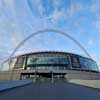
photo © Nick Weall
Emirates Stadium
Populous
Comments / photos for the London Olympics Stadium Architecture page welcome

